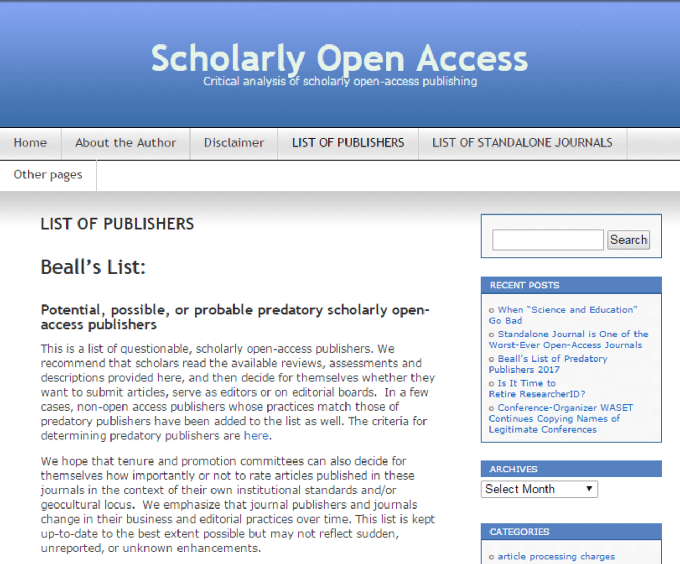For aficionados of bad science, the blog of University of Colorado librarian Jeffrey Beall was essential reading. Beall’s blog charted the murky world of predatory and vanity academic publishers, many of which charge excessive fees for publishing papers or have dysfunctional peer review processes.
I’ve seen rubbish on chemtrails, alien life, climate, HIV-AIDS and vaccines appear in these (unintended) parodies of academic publications. Although, to be honest, they can be a guilty pleasure of sorts. Perhaps I’m like a film buff getting a kick out of Ed Wood’s “Plan 9 from Outer space”.
But recently all of the content on Beall’s blog was wiped without any warning. While much of Beall’s blog is archived, it had been charting the evolution of predatory academic publishing, including conferences and the purchasing of existing journals. With Beall’s blog gone, it will become harder to keep track of the underbelly of academic publishing.
Changing face of scientific publishing
Traditionally, academic journals have been sustained via subscriptions, particularly those charged to academic libraries. Libraries would pick and choose which journals to subscribe to, in large part based on the requests of academics.
Subscriptions provided some incentive to maintain quality but also limited the readership of academic papers, effectively excluding the broader pubic (whose taxes often funded the research).
As the internet enabled the easy sharing of information, this is now extending to academic publications too. The “open access” model is increasingly popular, where authors are charged publication fees and the resulting papers are freely available online.
In principle, I like open access, as I believe science should be disseminated to the broadest audience possible. But there are perverse incentives. Will a publisher reject a manuscript that is manifestly rubbish, and forego the fees it would charge the author? In some cases the answer is “no”.
Furthermore, the shift from printed journals to online publications has facilitated predatory and vanity academic publishers. Computers and websites have replaced printing presses and bound volumes. One publisher on Beall’s list, Zant World Press, is run from a Melbourne suburban house.
Beall’s blog charted the explosion of predatory publishers exploiting the open access model. His list grew from just 18 publishers in 2011 to 1,155 publishers in 2017!
I, along with many others, found Beall’s list an incredibly useful resource. Suspicious scientific claims could often be traced back to journals associated with publishers on the list.
For example, in 2015 many newspapers printed claims that chocolate helped weight loss, but it was all a hoax, which included publishing a paper in the International Archives of Medicine, which was on Beall’s list.
I recently became aware of another prank, played at the expense of a predatory publisher. Astronomer Dominique Eckert submitted the joke paper “Get me off Your Fucking Mailing List” to IOSR journals. The paper consists of “get me off your fucking mailing list” repeated hundreds of times.
While one cannot fault the paper for clarity of expression, it isn’t suitable for an academic journal. But less than a week after Eckert submitted the paper, it was accepted for publication. The “reviewers comments” were “quality of manuscript is good”. Manuscript handling charges were US$75 (A$100).
Remarkably, this isn’t the first time a predatory publisher has accepted “Get me off Your Fucking Mailing List”. Peter Vamplew played the same prank in 2014.
Beall planned a post on Eckert’s prank for Thursday January 12, 2017, but it never happened. By then, all the content was wiped from the blog.
Why this happened isn’t yet clear. The University of Colorado says it was Beall’s personal decision. However, Lacey Earle, who has been working with Beall, tweeted that Beall “was forced to shut down blog due to threats and politics”.
Certainly there are many publishers and individuals who are no fan of Beall, and legal threats have been made in the past. Without a doubt, the blog has hurt some publishers’ reputations and bottom lines.
Indeed, Beall’s work certainly facilitated the US Federal Trade Commission charging OMICS Group with deceptive acts or practices in August 2016. OMICS has responded and described the allegations as “baseless”.
Changing times
A few years ago, predatory publishing often consisted of websites with stock images and poor grammar. Sometimes journal “editors” were revealed to be identities stolen off the web.
But, increasingly, predatory publishers are running academic conferences in countries around the globe, including the US and Australia. Often the conferences do not live up to their hype, as Radio National’s Hagar Cohen found when she attended an OMICS conference in Brisbane in 2015.
Predatory publishers are also buying existing journals in developed countries. Recently the Australasian Medical Journal‘s contact details shifted from Melbourne to London, and it now shares the postal address of iMedPub, an affiliate of OMICS.
Beall had been reporting this changing landscape of predatory publishing, and I suspect this is where the loss of his blog will have the greatest impact. That said, Beall’s archived list will long remain a valuable resource. And perhaps most importantly, he made the community aware of the threat of predatory academic publishing.
Author Bio: Michael J. I. Brown is an Associate professor at the Monash University


